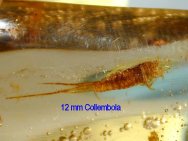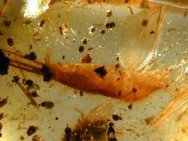|
Collembola
Fossil Insects - Springtails |
Page
within: Insect Fossils Of related interest: Fossil Amber (Resin) |
|
The
Collembola (commonly referred to as springtails) are belived to
form a monophyletic group i.e. they evolved from a single common
ancestor during the Devonian.
Not only does insect group Collembolla comprise some of the most
primitive insects, but their direct ancestor may have been among
the first arthropods
to transition from a marine environment to land. The oldest fossil
Collembolan, Rhyniella praecursor was taken from Lower Devonian
beds of the Rhynie chert in England. In spite of the early occrence,
the fossil record has no trace of Collembola between the Devonian
and the Cretaceous, and even after that the record is very sparse.
Most fossil springtails have been described form fossil
amber, and with very few exceptions respresent extant genera.
Collembola
are distiguished by a special tube on the ventral side of the first abdominal
segment that apparently evolved for fluid exchange; Collembola, derives from the
Greek words 'cole', meaning glue, and 'embolon', meaning piston. The tube is a
'glue piston' because some Collembola use it for adhering to smooth surfaces. | ||||||
|
Fossil
Museum Navigation:
Home Geological Time Paleobiology Geological History Tree of Life Fossil Sites Fossils Evolution Fossil Record Museum Fossils |



